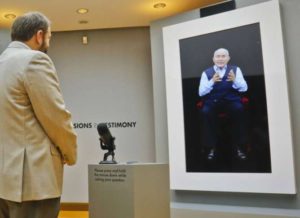By Shari Goldstein Stern
The Museum of Biblical Art (MBA) on Park Lane at Boedecker across from NorthPark Center might easily be missed if it’s not on your radar. When you do visit, your first impression will be of a distinctive collection of metal sculpture on the well-manicured grounds. If it’s cooler than 95 degrees, you will want to take time to examine the meticulous detail and information about each piece.
Inside is a mélange of 11 unique galleries including an Art Conservation Lab, Via Dolorosa Sculpture Garden and others for art appreciators of every age, background and belief. The art converges all religions across the world. Among the readily-recognized artists and artisans whose work is represented at the MBA are Marc Chagall, Ira Moskowitz and nationally-recognized Dallas sculptor George Tobolowsky.
In 2014, the National Center for Jewish Art (NCJA) was founded at the MBA. The center houses an extensive collection of metal sculpture, religious symbols, portraits, silkscreen panels and more by Israeli and Jewish artists.
According to Scott Peck, MBA curator: “Over 10,000 square feet are dedicated to the exhibition and display of Jewish art including the NCJA gallery space and the Chagall Ballroom. The exhibition’s purpose is to bring contemporary Israeli and Jewish art to a broader audience and to break down prejudice and misconceptions.”
The center also introduces a new, technological method of learning first-hand about a dark period in European and global history — The Holocaust.
“New Dimensions in Testimony Technology” (NDTT), is a wave of cutting-edge innovations through which survivors are immortalized with holograms capable of answering as many as 2,000 questions about themselves, their families and their experiences during the Holocaust. The technology combines high-definition recording, voice activation and holographic imagery to create an interactive, 3-D educational experience between visitors and survivors to be appreciated into perpetuity. Chicago, Toronto and Houston are among the other handful of U.S. museums with this technology.
The images are produced by the University of Southern California’s (USC) Institute for Creative Technologies, along with the USC Shoah Foundation — a nonprofit that director Steven Spielberg founded in 1994 to preserve Holocaust and other genocide survivor testimonies.
Holocaust survivor Pinchas Gutter is at the heart of MBA’s exhibit, as he sits in a chair, introduces himself and then asks if there are any questions. With the program’s design, Pinchas can answer about 200. Pinchas looks you in the eye as though you are directly in front of him. He moves as he normally would sitting in a chair. Pinchas happens to be very animated, using his hands and fluid facial expression with every word. Watching his eyes is like a witnessing a miracle happening. It feels like you’re sitting in your living room visiting with a conversant Holocaust survivor who has plenty of profound, difficult stories to tell. With a few answers, Pinchas becomes emotional and must pause for a moment. Thankfully, Pinchas is very much alive and active today at his home in Toronto with his family. Someday, he’ll be legendary to them, his friends and those who have the honor of meeting him in the future through technology. It is hard to say and heart-wrenching to realize that the numbers of WWII Holocaust survivors are dwindling. Who will continue telling their stories when they are gone? They will.
The museum is located at 7500 Park Lane, Dallas, 75225. Call 214-368-4622 for more information.

